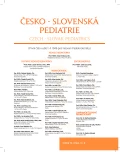Congenital laryngeal cyst – a rare cause for severe obstruction of upper airways
Authors:
B. Uhliarová 1; G. Bugová 2; S. Nosáľ 3; P. Ďurdík 4; M. Zibolen 5; A. Hajtman 2
Authors‘ workplace:
ORL oddelenie, FNsP F. D. Roosevelta, Banská Bystrica
1; Klinika ORL a ChHaK UK JLF a UNM, Martin
2; Klinika detskej anesteziológie a intenzívnej medicíny UK JLF a UNM, Martin
3; Klinika detí a dorastu UK JLF a UNM, Martin
4; Klinika neonatológie UK JLF a UNM, Martin
5
Published in:
Čes-slov Pediat 2017; 72 (6): 341-344.
Category:
Case Report
Overview
Congenital high airway obstruction syndrome (CHAOS) is a rare but life-threatening condition that results from the obstruction of the upper airways. The most common cause for CHAOS are laryngeal atresia, subglottic stenosis and complete diaphragm of larynx.
Congenital laryngeal cysts are rare condition. Although it may cause a significant obstruction of the upper airways, it generally does not significantly narrow the airways. Young children are often asymptomatic.
In this report, a newborn with severe airway obstruction at birth, caused by a giant congenital laryngeal cyst, is presented.
KEY WORDS:
obstruction of upper airways, congenital laryngeal cyst, congenital laryngeal anomalies
Sources
1. Janoušek P, Kabelka Z, Marková M. Zúžení hrtanu a průdušnice u dětí. Otorinolaryng a Foniat (Prague) 2006; 55 (3): 161–167.
2. Klochanová I, Jovankovičová A, Staníková A, Majáková L. Diferenciálna diagnostika inspiračného stridoru ako vrodenej vývojovej anomálie. Pediatr Prax 2015; 16 (2): 57–61.
3. Kapellerová A, Dzurenková A. Stridor v detskom veku – príčiny a diagnóza. Pediatr Prax 2008; 1: 12–14.
4. Hedrick MH, Ferro MM, Filly RA, et al. Congenital high airway obstrution syndrome (CHAOS): a potential for perinatal intervention. J Pediatr Surg 1994; 29: 271–274.
5. Vanhaesebrouck P, Coen K, Defoort P, et al. Evidence for autosomal dominant inheritance in prenatally diagnosed CHAOS. Eur J Pediatr 2006; 165: 706–708.
6. Cunha MS, Janeiro P, Fernandes R, et al. Congenital laryngomucocoele: a rare cause for CHAOS. BMJ Case Rep 2009; 2009: bcr07.2008.0595.
7. Kislal FM, Acar B, Inan Y, Degerli S, Günbey E. Giant congenital epiglottic cyst presenting with airway obstruction at birth. J Craniofac Surg 2012; 23 (2): 602–603.
8. Prowse S, Knight L. Congenital cysts of the infant larynx. Int J Pediatr Otorhinolaryngol 2012; 76 (5): 708–711.
9. Okuyama H, Kubota A, Kawahara H, et al. Congenital laryngeal atresia associated with esophageal atresia and tracheoesophageal fistula: a case of long-term survival. J Pediatr Surg 2006; 41: E29–32.
10. Lim BF-Y, Crombleholme TM, Hedrick HL, et al. Congenital high airway obstrution syndrome: natural history and management. J Pediatr Surg 2003; 38: 940–945.
11. Shimabukuro F, Sakumoto K, Masamoto H, et al. A case of congenital high airway obstruction syndrome managed by ex-utero intrapartum treatment: case report and review of the litararture. Am J Perinatol 2007; 24: 197–201.
12. Ferianec V. Fetálna terapia. Bratislava: Univerzita Komenského, Lekárska fakulta, 2014: 1–97.
13. Hirose S, Harrison MR. The ex utero intrapartum treatment (EXIT) procedure. Semin Neonatol 2003; 8: 207–214.
14. Lim BF-Y, Crombleholme TM, Hedrick HL, et al. Congenital high airway obstrution syndrome: natural history and management. J Pediatr Surg 2003; 38: 940–945.
15. Bouchard S, Johnson MP, Flake AW, et al. The EXIT procedure: experience and outcome in 31 cases. J Pediatr Surg 2002; 37: 418–426.
Labels
Neonatology Paediatrics General practitioner for children and adolescentsArticle was published in
Czech-Slovak Pediatrics

2017 Issue 6
Most read in this issue
- Holoprosencephaly – case report
- Physical activity guidelines for Slovak children and youth (6–18 yr.)
- Nonhealing atopic eczema
- The specific care about children born with assisted reproduction
